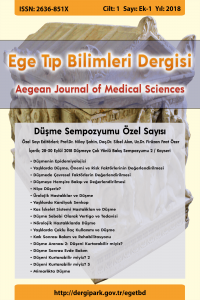Abstract
Bireyin dikkatsizliği nedeniyle,
bulunduğu seviyeden daha aşağıda hareketsiz hale gelmesine düşme denir. Yaşlı
toplumda majör bir halk sağlığı problemi ve ciddi bir sosyoekonomik yük olarak
karşımıza çıkmaktadır. Sakatlık ve
kişisel yetersizliğin en sık sebebi olan düşmeye zemin hazırlayan fiziksel
çevresel etkenlerin çoğu düzeltilebilir görünmektedir.
Yaş ilerledikçe görülme sıklığı artan
düşme sonucu yaşlılarda kırık ve ciddi yumuşak doku yaralanmaları oluşmaktadır.
Bu hastalarda en sık alt ekstremite yaralanmaları görülürken el bilek kırıkları
65–75 yaş arası, kalça kırıkları tim75
yaş sonrası daha sık görülmektedir.
Düşmeye eğilimin olmasıyla beraber
koruyucu reflekslerde yavaşlama gibi fizyolojik değişikliklerin olması, basit
bir düşmeyi tehlikeli noktalara getirmekte, iyileşme süresinin gecikmesi de
işlevselliğin kazanılmamasına bağlı olarak takip eden düşme riskini
artırmaktadır.
Düşmelerin en sık sebebi “kaza veya
çevresel faktörler” olarak görülürken, birden fazla sistemin uyumunun bozulması
sonucu ortaya çıkan yürüyüş ve denge bozuklukları ise ikinci en sık neden
olarak karşımıza çıkar. Diz osteoartriti, diyabet gibi hastalığı bulunan
yaşlılarda düşme oranları yüksektir ve kronik hastalık sayısı arttıkça düşme
riski de artmaktadır.
Sonuç olarak ülkemizde yaşlı
popülasyonu arttığından düşmeler sıklaşmakta ve büyük bir halk sağlığı sorunu
olarak karşımıza çıkmaktadır. Düşme nedenlerinin çoğunun ev içi kaynaklı olduğu
ve düşük enerjili travma ile gerçekleştiği göz önüne alınırsa bu etyolojik
etkenlerin pek çoğunun düzeltilebileceği kanaatindeyim.
References
- 1. Zecevic AA, Salmoni AW, Speechley M, Vandervoort AA. Defining a fall and reasons for falling: comparisons among the views of seniors, health care providers, and the research literature. Gerontologist. 2006;46(3):367-76.
- 2. Holtzer R, Friedman R, Lipton RB, Katz M, Xue W, Verghese J. The relationship between specific cognitive functions and falls in aging. Neuropsychology. 2007;21(5):540-8.
- 3. Heinrich S, Rapp K, Rissmann U, Becker C, Konig H. “Cost of falls in old age: a systematic review,” Osteoporosis International. 2010;21(6):891-902.
- 4. M. Sartini, M. L. Cristina, A. M. Spagnolo et al. “The epidemiology of domestic injurious falls in a community dwelling elderly population: an outgrowing economic burden,” European Journal of Public Health. 2010;20(5):604-6.
- 5. Provider S-SAI, 2011, http://www.suva.ch/startseite-suva/praevention- suva/arbeit-suva/stolpern-ch-suva/fit-durch-den-winter- suva.htm.
- 6. Moore M,Williams B, Ragsdale S et al. “Translating a multifactorial fall prevention intervention into practice: a controlled evaluation of a fall prevention clinic,” Journal of the American Geriatrics Society. 2010;58(2):357-63.
- 7. Frick KD, Kung JY, Parrish JM, Narrett MJ. “Evaluating the cost-effectiveness of fall prevention programs that reduce fall-related hip fractures in older adults,” Journal of the American Geriatrics Society. 2010;58(1):136-41.
- 8. Masud T, Morris RO. Epidemiology of falls. Age Ageing. 2001;30:3–7.
- 9. Tinetti ME, Doucette J, Claus E, Marottoli RA. Risk factors for serious injury during falls by older persons in the community. J Am Geriatr Soc. 1995;43:1214-21.
- 10. Kiel DP, O'Sullivan P, Teno JM, Mor V. Health care utilization and functional status in the aged following a fall. Med Care. 1991;29:221-8.
- 11. Kara H, Bayir A, Ak A, Akıncı M, Tüfekci N, Degırmencı S, Azap M. Trauma in elderly patients evaluated in a hospital emergency department in Konya, Turkey: a retrospective study. Clinical Interventions in Aging. 2014;6:17-21.
- 12. Rubenstein LZ. Falls in older people: epidemiology, risk factors and strategies for prevention. Age & Aging. 2006;35:37-41.
- 13. Austin N, Devine A, Dick I, Prince R, Bruce D. Fear of falling in older women: a longitudinal study of incidence, persistence, and predictors. J Am Geriatr Soc. 2007;55:1598-603.
- 14. Jensen J, Nyberg L, Gustafson Y, Lundin-Olsson L. Fall & injury prevention in residential care effects in residents with higher & lower levels of cognition. J Am Geriatr Soc. 2003;51:627–35.
- 15. Naharcı MI, Doruk H. Yaşlı popülasyonda düşmeye yaklaşım. TAF Prev Med Bull. 2009;8(5):437-44.
- 16. Tinetti ME. Clinical practice. Preventing falls in elderly persons. N Engl J Med. 2003;348:42-9.
- 17. Lord SR, Dayhew J, Howland A. Multifocal glasses impair edge-contrast sensitivity and depth perception and increase the risk of falls in older people. J Am Geriatr Soc. 2002;50:1760- 6.
- 18. DeMott TK, Richardson JK, Thies SB, Ashton-Miller JA. Falls and gait characteristics among older persons with peripheral neuropathy. Am J Phys Med. Rehabil. 2007;86(2):125-32.
- 19. Maki BE, McIlroy WE. Postural control in the older adult. Clin Geriatr Med. 1996;12: 635-8.
- 20. Carpenter CR, Scheatzle MD, D’Antonio JA, Ricci PT, Coben JH. Identification of fall risk factors in older adult emergency department patients. Acad Emerg Med. 2009;16(3):211-9.
- 21. Lawlor DA, Patel R, Ebrahim S. Association between falls in elderly women and chronic diseases and drug use: cross sectional study. BMJ. 2003;327:712-7.
- 22. Işık AT, Cankurtaran M, Doruk H, Mas R. Geriatrik olgularda düşmelerin değerlendirilmesi. Turkish Journal of Geriatrics. 2006;9(1):45-50.
Details
| Primary Language | Turkish |
|---|---|
| Subjects | Surgery |
| Journal Section | Review |
| Authors | |
| Publication Date | December 29, 2018 |
| Acceptance Date | December 5, 2018 |
| Published in Issue | Year 2018 Düşmeye Çok Yönlü Bakış Sempozyumu ll Özel Sayısı |
The articles published in this journal are licensed under Creative Commons Attribution-NonCommercial 4.0 International License (CC BY-NC 4.0).

